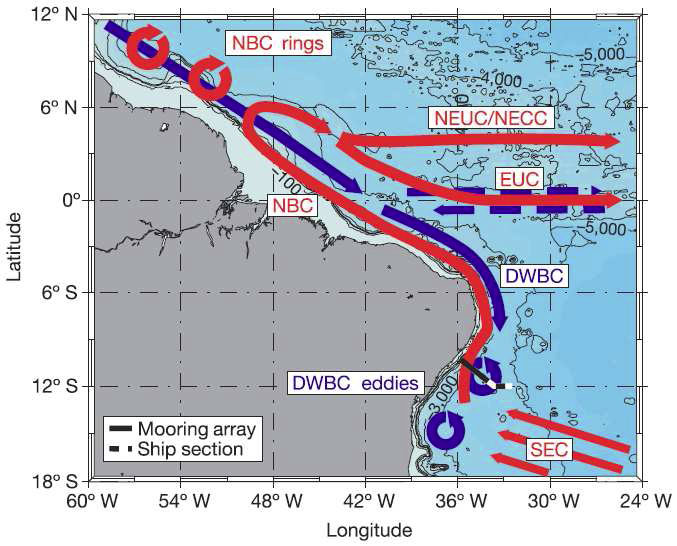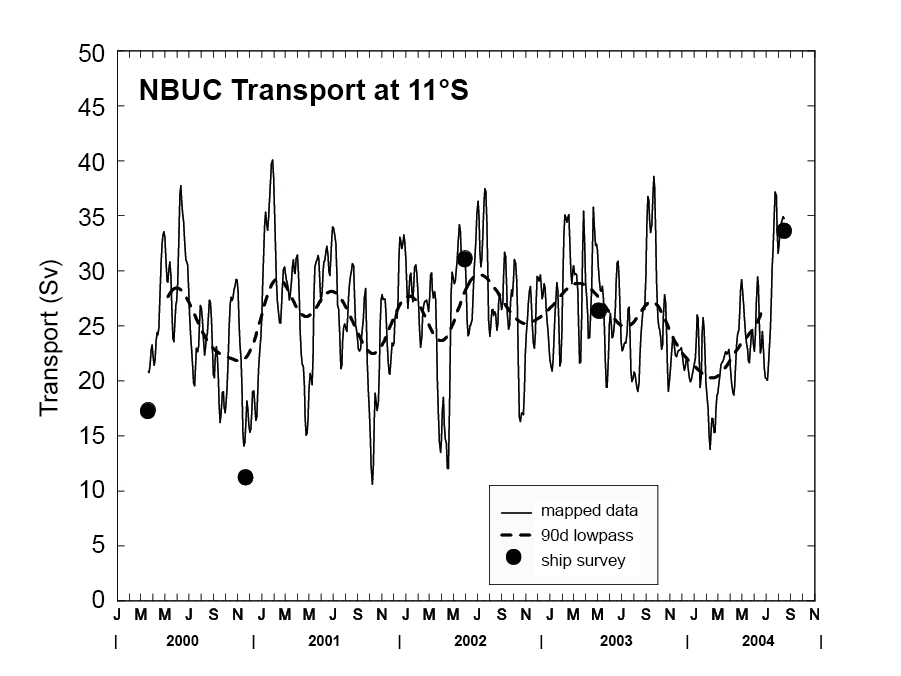The tropical Atlantic Ocean plays an important role for climate variability in the Atlantic region. The circulation within the tropical Atlantic is a superposition of the wind driven circulation, the meridional overturning circulation (AMOC) and the subtropical cells (STCs) of both hemispheres. Thus, the variability of the circulation within this area has extensive consequences for the oceanic variability in remote regions of the North and South Atlantic, as well as for the climate. A key region within the tropical Atlantic is the western boundary current system offshore of South America. The North Brazil Undercurrent (NBUC) reacts very sensitive to variations of the AMOC and the STCs and therefore serves as an ideal investigation area. In sub-project 1.1, the western boundary current system off the coast of Brazil at 11° S (Fig. 1) will be investigated with a mooring array and ship based observations including direct current as well as hydrographic measurements. The observed variability of the western boundary current system will be related to the variability of the AMOC at the deep water formation sites of the North Atlantic as well as the Agulhas region concerning the signal propagation within the AMOC. The comparison with timeseries obtained between 2000 and 2004 at the same location (Fig. 2) opens the possibility to not only analyze the seasonal, but also inter-annual to decadal variability of the transport and water mass properties in the western boundary current system. Strong multi-decadal variability with a doubling of the NBUC transport has been recently reported from the analysis of historical hydrographic data (Zhang et al., 2011), but could up to date not be confirmed with direct current measurements. Furthermore, possible connections between the new transport time series of the NBUC and the transport variability of the Equatorial Undercurrent (EUC) as well as the resulting consequences for the climate relevant sea surface temperatures (SST) of the equatorial East Atlantic will be analyzed. It has been shown that the variability of SSTs within the eastern equatorial Atlantic impacts rainfall variability in the tropical Atlantic region and especially influences the strength and onset of the West African monsoon thereby affecting droughts and epidemics in Westafrica. This socio-economic impact requires a better understanding of the role of the tropical ocean for long term climate variability aiming at evaluating the risks, validating numerical models and eventually improving forecasts of climate variability.
In order to achieve the main goal – to improve the understanding of the tropical Atlantic for climate variability in the Atlantic region –the following points will be investigated:
- the northward transport of central and intermediate water within the NBUC as part of the AMOC and the STC;
- transport variability of the boundary current system on intra-seasonal to decadal time scales;
- the connection between transport variations in the western boundary current system of the tropical South Atlantic (warm and cold water route, see Figure) and the variability of the subpolar North Atlantic with respect to the signal propagation within the AMOC;
- the propagation of water mass anomalies within the AMOC;, which could e.g. be caused by variations in the supply of salty waters from the Indian ocean;
- the connection between NBUC variability at 11° S and EUC variability at 23°W and its relevance for the heat and freshwater balance of the mixed layer in the tropical Atlantic with respect to ocean-atmosphere interactions and the resulting rainfall variability over Westafrica




